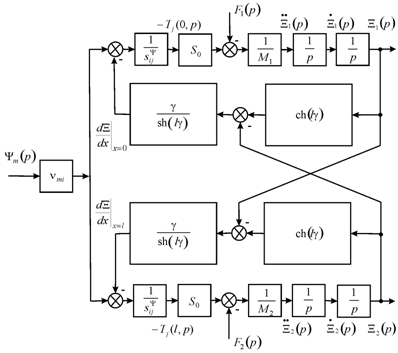Journal of
eISSN: 2377-4282


Mini Review Volume 7 Issue 4
National Research University of Electronic Technology, Russia
Correspondence: Afonin SM, National Research University of Electronic Technology, Russia
Received: May 16, 2018 | Published: July 18, 2018
Citation: Afonin SM. Electromagnetoelastic actuator for nanomedicine research. J Nanomed Res. 2018;7(4):231-233. DOI: 10.15406/jnmr.2018.07.00192
In this work the static and dynamic characteristics, the structural diagram and the transfer functions of the electromagnetoelasticactuator are obtained. The generalized structural diagram, the matrix transfer functions of the electromagnetoelastic actuator make it possible to describe the static and dynamic characteristics of the actuator with regard to its physical parameters, external load.
Keywords: electromagnetoelasticactuator, piezoactuator, structural diagram, transfer function, static and dynamic characteristics
The electromagnetoelastic actuator for nanodisplacement on the piezoelectric, piezomagnetic, electrostriction, magnetostriction effects is used in the electromechanics systems for the nanomedicine research in the scanning sensing microscopy and the adaptive optics.1‒8 For designing the nanotechnology equipment the static and dynamic characteristics, the mathematical model, the structural diagram and transfer functions of the electromagnetoelastic actuator are calculated.9‒18 The mathematical model, the structural diagram and transfer functions the electromagnetoelastic actuator based on the electromagnetoelasticity make it possible to describe the dynamic and static properties of the electromagnetoelastic actuator for the nanomedicine research with regard to its physical parameters and external load.19‒24 The static and dynamic characteristics, the mathematical model, the structural diagram and transfer functions of the electromagnetoelastic actuator are used for the nanomedicine research with the scanning sensing microscopy.
Let us consider the structural diagram of the electromagnetoelastic actuator for the nanomedicine research in contrast Cady and Mason electrical equivalent circuits. The method of mathematical physics is applied for the solution the wave equation and for the determination the structural diagram of the electromagnetoelastic actuator for nanomedicine research.1‒18 The mathematical model and the generalized structural diagram of the actuator 7,14 on (Figure 1) are determined,using method of the mathematical physics for the joints solution of the wave equation, the boundary conditions and the equation of the electromagnet elasticity, in the form
Ξ1(p)=[1/(M1p2)]××{−F1(p)+(1/χΨij)[νmiΨm(p)−[γ/sh(lγ)][ch(lγ)Ξ1(p)−Ξ2(p)]]}
(1)
Ξ2(p)=[1/(M2p2)]××{−F2(p)+(1/χΨij)[νmiΨm(p)−[γ/sh(lγ)][ch(lγ)Ξ2(p)−Ξ1(p)]]}
(2)
Where vmi={d33,d31,d15g33,g31,g15d33,d31,d15
, Ψm={E3,E1D3,D1H3,H1
, sΨij={sE33,sE11,sE55sD33,sD11,sD55sH33,sH11,sH55
(3)
cΨ={cEcDcH
, γ={γEγDγH
, l={δhb
, χΨij=sΨij/S0
(4)

Figure 1 Generalized structural diagram of electromagnetoelastic actuator for the nanomedicine research.
vmi is the coefficient electromagnetoelasticity, Ψm={Em,Dm,Hm is the control parameter, Em is the electric field strength for the voltage control along axis m, Dm is the electric induction for the current control along axis m, Hm for magnetic field strength control along axis m, dmi is the piezomoduleat the voltage-controlled piezoactuator or the coefficient of the magnetostriction at the magnetostrictive actuator, gmi is the piezomoduleat the current-controlled piezoactuator,sΨij is the elastic complianceat Y = const, S0 is the cross section area, M1, M2 are the mass on the faces of the actuator,Ξ1(p) ,Ξ2(p) and F1(p) , F2(p) are the Laplace transforms of the appropriate displacements and the forces on the faces 1, From equations of the forces acting on the faces of the actuator, the equation of the electromagnetoelasticity, the wave equation we obtain the generalized structural diagram of the electromagnetoelastic actuator. The structural diagrams of the voltage-controlled or current-controlled piezoactuator are determined from the mathematical model of the electromagnetoelastic actuator. (Figure 1) The generalized transfer functions of the of the electroelastic actuator are the ratio of the Laplace transform of the displacement of the face actuator and the Laplace transform of the corresponding control parameter or the force at zero initial conditions.
The matrix transfer function of the actuator is deduced from its mathematical model (4)8,14,18 in the form
(Ξ(p))=(W(p)) (P(p)) (5)
(Ξ(p))=(Ξ1(p)Ξ2(p)) ,
(W(p))=(W11(p)W12(p)W13(p)W21(p)W22(p)W23(p))
(P(p))=(Ψm(p)F1(p)F2(p))Where (Ξ(p)) is the column-matrix of the Laplace transforms of the displacements for the faces of the electromagnetoelastic actuator, (W(p)) is the matrix transfer function, (P(p)) the column-matrix of the Laplace transforms of the control parameter and the forces.
At Ψm=E3 and vmi =d31 we have transfer functions of the piezoactuator in the form
W11(p)=Ξ1(p)/E3(p)=d31[M2χE11p2+γth(hγ/2)]/A11 χE11=sE11/S0 A11=M1M2(χE11)2p4+{(M1+M2)χE11/[cEth(hγ)]}p3++[(M1+M2)χE11α/th(hγ)+1/(cE)2]p2+2αp/cE+α2 W21(p)=Ξ2(p)/E3(p)=d31[M1χE11p2+γth(hγ/2)]/A11 W12(p)=Ξ1(p)/F1(p)=−χE11[M2χE11p2+γ/th(hγ)]/A11 W13(p)=Ξ1(p)/F2(p)==W22(p)=Ξ2(p)/F1(p)=[χE11γ/sh(hγ)]/A11 W23(p)=Ξ2(p)/F2(p)=−χE11 [M1χE11p2+γ/th(hγ)]/A11The static characteristics of the actuator ξ1(∞) and ξ2(∞) have the form
ξ1(∞)=νmiΨm0l(m/2+M2)/(m+M1+M2) (6)
ξ2(∞)=νmiΨm0l(m/2+M1)/(m+M1+M2) (7)
The generalized structural scheme and the generalized transfer functions of the electromagnetoelastic actuator nano- and micro displacement are obtained from the generalized structural parametric model of the electromagnetoelastic actuator for the precision mechanics.
ξ1(∞)+ξ2(∞)=νmiΨm0l (8)
Where m, M1, M2 are the mass of the actuator and load masses.
Let us consider the voltage-controlled the piezoactuator from PZT at the longitudinal piezo effect for m<<M1 ,m<<M2 .Atd33=4⋅10−10 m/V, U=150 V, M1 =1kg, M2=4kg the static characteristics of the actuatorhave following form ξ1(∞)=48 nm,ξ2(∞)=12 nm,ξ1(∞)+ξ2(∞)=60 nm.
The transfer function of the voltage-controlled transverse piezoactuator at , M1→∞ have the form
m<<M2 , W(p)=Ξ2(p)U(p)=ka11T2t11p2+2Tt11ξt11p+1 ka11=d31h/δ1+Ce/CE11 Tt11=√M2/(C+eCE11) ξt11=αh2CE11/(3cE√M2(Ce+CE11))Were Tt11 is the time constant and ξt11 is the damping coefficient for the piezoactuator. AtM1→∞ ,m<<M2 . d31 = 2.10-10 m/V, h/δ=20 , M2 = 1kg, CE11=2.4⋅107 N/m,Ce=0.1⋅107 H/m the parameters of the transfer function have the form ka11=3.84 nm/V, Tt11= 0.2.10-3 c. Accordingly the static and dynamic characteristics of the voltage-controlled transverse piezoactuator for the nanomedicine research are determined.
The static and dynamic characteristics, the mathematical model, the structural diagram and transfer functions of the electromagnetoelastic actuator for the nanomedicine research are obtained. The generalized structural diagram, the transfers functions of the electromagnetoelastic actuator make it possible to describe the dynamic and static properties of the actuator with regard to its physical parameters, external load.
None.
Author declares there is no conflict of interest.

©2018 Afonin. This is an open access article distributed under the terms of the, which permits unrestricted use, distribution, and build upon your work non-commercially.